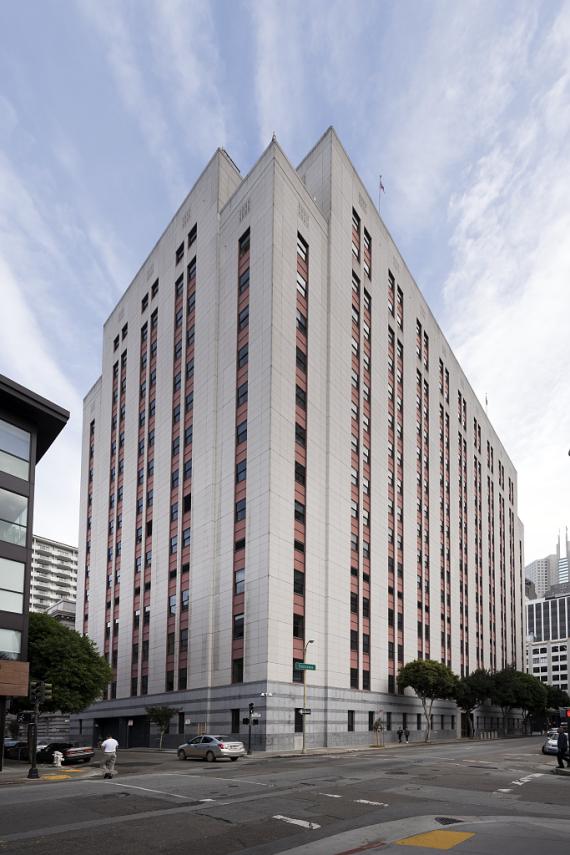Location: 630 Sansome St, San Francisco, CA 94111
The United States Immigration Station and Appraisers Stores, San Francisco (now commonly called the Appraisers Building), has been associated with events that have made a significant contribution to the broad patterns of American history. The building housed immigration and customs agencies of the Federal government since its completion in 1944 and still retains associations with these functions of the government. Although substantially altered in 1985-88, the building embodies distinctive architectural characteristics spanning two significant periods in American architecture, the Depression and World War II, and is the work of an important American architect, Gilbert Stanley Underwood.
In 1874, the first Appraisers and Immigration Building, a four-story brick warehouse structure designed by Alfred B. Mullet, Supervising Architect of the United States Treasury, was built on this site for the inspection of goods. Customs Houses have occupied the eastern end of this block since 1855, when the first of two customs houses was built. The largest of the two, begun in 1906, still occupies the eastern portion of the block. During the late 1800s, the Port of San Francisco was still the largest port on the West Coast and the primary transfer point for international and domestic shipping.
In 1939, when construction of the Appraisers Building was begun, freight and most goods were still shipped by sea, although truck transportation had become an increasingly important means of domestic transport. In general, most of the requirements for appraisal, storage and testing remained the same for the new structure as for the 1874 building. A loading dock was, however, included to accommodate trucked freight.
Rapid changes in transportation after World War II had a significant affect on the use of the Appraisers Building. On the local level, the development of the Naval Supply Depot in Oakland, California, during World War II, accelerated the commercial development of the Port of Oakland and, consequently, drew commerce away from the Port of San Francisco. On the national level, air freight became increasingly important. By the 1950s, the popularity of air freight had increased, at the expense of the Port of San Francisco. Since the completion of the Appraisers Building in 1944, the need for freight inspection and investigation at local airports and other ports of entry increased and the need for U. S. Customs warehouse, appraisal, and laboratory functions at the Port of San Francisco has significantly reduced. Today, these Customs functions occupy about one quarter of their original square footage in the Appraisers Building.
The Appraisers Building was designed as a replacement for the Angel Island quarantine station operated by the U.S. Immigration and Naturalization Service (INS). Upper floors of the Appraisers Building were originally a “detention hotel” with private rooms, dormitories, day rooms, outdoor terraces, and multiple kitchens to provide for various ethnic cuisine. These spaces were utilized until about 1960, after which the I.N.S. ceased detaining any persons overnight in the Appraisers Building.
Again, rapidly changing modes of travel were in part the cause of obsolescence of the I.N.S. functions at the facility. Although commercial air travel had been inaugurated just prior to World War II, all Asian immigrants were still expected to arrive by ship when the building was designed. The building program provided for facilities for immigrants required to wait for days or weeks until their documents could be cleared, or until a hearing could be held, or until they could be deported. The total immigration from China and Japan in the decade 1941-1950 was only 3,100 persons, representing the majority of Asian immigrants at the time. Only a small percentage of these immigrants were detained and housed in the Appraisers Building. By contrast, in the year 1990 alone, 50-60,000 persons entered the San Francisco Bay area from Asia, largely on immigrant visas and largely by airplane.
Inconvenient to the airports and too small to be used as a detention center, these functions have been relocated to other I.N.S. facilities, and the Appraisers Building has become a regional administrative center for the I.N.S. Approximately 1,000 persons a day visit the facility, primarily to attend to paperwork, obtain Green Cards or for immigration and naturalization hearings.
Building Facts
- Architect: Gilbert Stanley Underwood
- Construction Dates: 1939-1944
- GSA Building Number: CA0091AA
- Landmark Status: Listed in the National Register of Historic Places

 U.S. General Services Administration
U.S. General Services Administration
